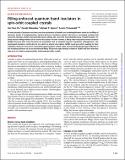Filling-enforced quantum band insulators in spin-orbit coupled crystals
Author(s)
Po, H. C.; Zaletel, M. P.; Vishwanath, A.; Watanabe, Haruki
Downloade1501782.full.pdf (1.346Mb)
PUBLISHER_POLICY
Publisher Policy
Article is made available in accordance with the publisher's policy and may be subject to US copyright law. Please refer to the publisher's site for terms of use.
Terms of use
Metadata
Show full item recordAbstract
An early triumph of quantum mechanics was the explanation of metallic and insulating behavior based on the filling of electronic bands. A complementary, classical picture of insulators depicts electrons as occupying localized and symmetric Wannier orbitals that resemble atomic orbitals. We report the theoretical discovery of band insulators for which electron filling forbids such an atomic description. We refer to them as filling-enforced quantum band insulators (feQBIs) because their wave functions are associated with an essential degree of quantum entanglement. Like topological insulators, which also do not admit an atomic description, feQBIs need spin-orbit coupling for their realization. However, they do not necessarily support gapless surface states. Instead, the band topology is reflected in the insulating behavior at an unconventional filling. We present tight binding models of feQBIs and show that they only occur in certain nonsymmorphic, body-centered cubic crystals.
Date issued
2016-04Department
Massachusetts Institute of Technology. Department of PhysicsJournal
Science Advances
Publisher
American Association for the Advancement of Science (AAAS)
Citation
Po, H. C. et al. “Filling-Enforced Quantum Band Insulators in Spin-Orbit Coupled Crystals.” Science Advances 2, 4 (April 2016): e1501782–e1501782 © 2016 The Authors
Version: Final published version
ISSN
2375-2548